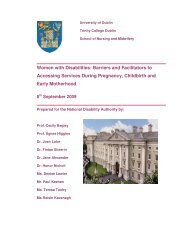Literature Review on Provision of Appropriate and Accessible ...
Literature Review on Provision of Appropriate and Accessible ...
Literature Review on Provision of Appropriate and Accessible ...
You also want an ePaper? Increase the reach of your titles
YUMPU automatically turns print PDFs into web optimized ePapers that Google loves.
PAGE 41<br />
McCarthy (1999: 221), who carried out research with women with<br />
learning disabilities in Engl<strong>and</strong>, notes that the reliance <strong>on</strong> low/no<br />
maintenance methods, such as those described above (Chamberlain et<br />
al., 1984), assumes that women with learning disabilities are incapable<br />
or unreliable when it comes to managing their own fertility. She suggests<br />
that as new forms <strong>of</strong> slow-release, l<strong>on</strong>g-acting c<strong>on</strong>tracepti<strong>on</strong> (such as<br />
implants) come <strong>on</strong>to the market <strong>on</strong>e could expect these to be over-used<br />
as well (McCarthy <strong>and</strong> Thomps<strong>on</strong>, 1998). It has also been argued that<br />
the use <strong>of</strong> l<strong>on</strong>g-lasting c<strong>on</strong>tracepti<strong>on</strong> like Depot Medroxyprogester<strong>on</strong>e<br />
Acetate reveals pressures to discourage the fertility <strong>of</strong> certain groups<br />
<strong>of</strong> women (Williams, 1992). IUDs are not generally the c<strong>on</strong>tracepti<strong>on</strong><br />
<strong>of</strong> choice <strong>of</strong> younger women without learning disabilities, yet they are<br />
frequently used for women with learning disabilities (Chamberlain et al.,<br />
1984; Elkins et al., 1994).<br />
Support to People with an Intellectual Disability who are<br />
<strong>Accessible</strong><br />
<strong>and</strong> <strong>Appropriate</strong> <strong>of</strong> Provisi<strong>on</strong> <strong>on</strong> <str<strong>on</strong>g>Review</str<strong>on</strong>g> <str<strong>on</strong>g>Literature</str<strong>on</strong>g><br />
Experiencing Crisis Pregnancy<br />
McCarthy (1999:222) notes that the use <strong>of</strong> c<strong>on</strong>doms is menti<strong>on</strong>ed<br />
widely in the literature but this is almost exclusively in relati<strong>on</strong> to<br />
HIV preventi<strong>on</strong>. Use <strong>of</strong> the diaphragm: is almost entirely overlooked.<br />
McCarthy (1999) acknowledges the possible difficulties for a woman<br />
with learning disabilities in using a diaphragm: learning how to insert<br />
it properly, having to touch her genitals, inserting <strong>and</strong> removing it at<br />
the right times. The hurried nature <strong>of</strong> much <strong>of</strong> the sexual activity the<br />
women in her study reported to her would suggest that diaphragms<br />
would be impractical, as would the female c<strong>on</strong>dom for the same reas<strong>on</strong>s<br />
(McCarthy, 1999: 223).<br />
2.3.2 Factors influencing c<strong>on</strong>tracepti<strong>on</strong> usage<br />
Research has shown that the living envir<strong>on</strong>ment <strong>of</strong> women with<br />
intellectual disability is a determining factor in their use <strong>of</strong> c<strong>on</strong>tracepti<strong>on</strong><br />
<strong>and</strong> the type <strong>of</strong> c<strong>on</strong>tracepti<strong>on</strong> used. Servais et al.’s (2002) populati<strong>on</strong>based<br />
study involved a survey <strong>of</strong> 397 women with intellectual disability<br />
aged between 18 <strong>and</strong> 46 attending government-funded facilities in<br />
Brussels <strong>and</strong> the province <strong>of</strong> Wallo<strong>on</strong> Brabant in Belgium. [13] Of these<br />
women, over 40 per cent did not use any c<strong>on</strong>traceptive method, 22 per<br />
cent were sterilised, 18 per cent used an oral c<strong>on</strong>traceptive agent, <strong>and</strong><br />
13 Findings from the survey indicated that 7% <strong>of</strong> the women were having or<br />
previously had had c<strong>on</strong>senting sexual intercourse; 51% were not sexually active,<br />
<strong>and</strong> this informati<strong>on</strong> was not known for 41% <strong>of</strong> the women.
















